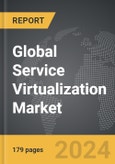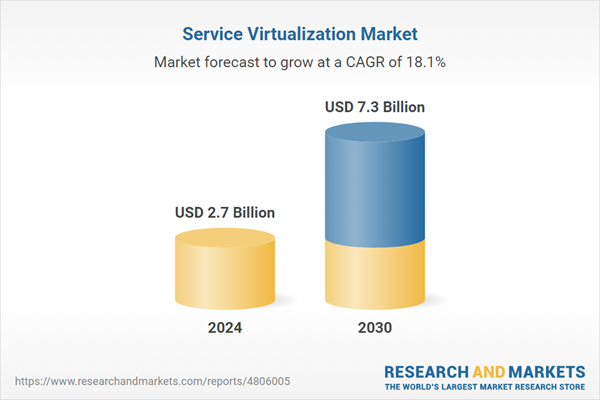Global Service Virtualization Market - Key Trends and Drivers Summarized
Why Is Service Virtualization Becoming Essential for Agile Development?
Service virtualization is becoming essential for agile software development and testing as it enables developers and testers to simulate the behavior of complex, interdependent services and systems, allowing for continuous integration, testing, and deployment. Unlike traditional development methods that rely on fully functional environments, service virtualization provides a virtualized environment where developers can test and validate their code early in the development cycle, reducing delays, costs, and risks associated with real-world dependencies. As organizations increasingly adopt DevOps, microservices, and cloud-native applications, the need for flexible, scalable, and cost-effective testing solutions is driving the adoption of service virtualization across industries such as finance, healthcare, telecommunications, and retail.How Are Technological Advancements Transforming Service Virtualization?
Technological advancements are transforming service virtualization by making it more powerful, automated, and intelligent. The integration of AI and machine learning into service virtualization platforms is enabling intelligent test data management, predictive analytics, and automated test scenario generation, driving more efficient and effective testing. The development of API management and microservices frameworks is enhancing the flexibility and reusability of virtual services, allowing for seamless integration with cloud-native and hybrid cloud environments. The rise of virtual service environments for mobile and web application testing is also expanding the scope and capabilities of service virtualization, enabling organizations to deliver high-quality applications faster. Additionally, the focus on improving performance, scalability, and environment configuration is making service virtualization a critical component of continuous testing and shift-left strategies.Which Market Segments Are Leading the Adoption of Service Virtualization?
Components include hardware, software and services, with software being the largest segment due to the need for advanced tools and platforms that support diverse testing environments. Deployment modes cover on-premises and cloud-based solutions, with cloud-based solutions gaining traction due to their scalability, flexibility, and cost-effectiveness. Applications include BFSI, healthcare, telecom, IT, and retail, with BFSI and IT being the largest segments due to their focus on reducing testing costs, improving software quality, and accelerating time-to-market. Geographically, North America and Europe are the leading markets for service virtualization due to advanced IT infrastructure, high digital adoption rates, and mature DevOps practices, while Asia-Pacific is emerging as a high-growth region driven by increasing investments in software development, cloud computing, and digital transformation.What Are the Key Drivers of Growth in the Service Virtualization Market?
The growth in the service virtualization market is driven by several factors, including the increasing demand for agile and continuous testing, advancements in AI and machine learning for intelligent test data management, and the rising adoption of DevOps, microservices, and cloud-native applications. The development of API-first and open-source service virtualization platforms with capabilities for real-time monitoring, environment simulation, and automated test orchestration is driving market adoption across BFSI, telecom, healthcare, and retail sectors. The focus on enhancing software quality, reducing release cycle times, and supporting shift-left testing strategies is expanding the market reach among enterprises, software vendors, and IT service providers. The growing emphasis on secure, scalable, and flexible virtual environments for regulated industries, mobile applications, and cloud-based deployments is creating new opportunities for market growth. Additionally, the increasing investments in R&D for next-generation service virtualization tools, AI-driven testing, and DevSecOps integration are further supporting market expansion.Report Scope
The report analyzes the Service Virtualization market, presented in terms of market value (USD). The analysis covers the key segments and geographic regions outlined below.- Segments: Component (Services, Software, Hardware); Deployment (On-Premise, Cloud); Application (IT Services, Telecommunications, BFSI, Retail & eCommerce, Media & Entertainment, Other Applications).
- Geographic Regions/Countries: World; United States; Canada; Japan; China; Europe (France; Germany; Italy; United Kingdom; and Rest of Europe); Asia-Pacific; Rest of World.
Key Insights:
- Market Growth: Understand the significant growth trajectory of the Service Virtualization Services segment, which is expected to reach US$3.8 Billion by 2030 with a CAGR of 19.7%. The Service Virtualization Software segment is also set to grow at 17.3% CAGR over the analysis period.
- Regional Analysis: Gain insights into the U.S. market, valued at $729.1 Million in 2024, and China, forecasted to grow at an impressive 16.7% CAGR to reach $1.1 Billion by 2030. Discover growth trends in other key regions, including Japan, Canada, Germany, and the Asia-Pacific.
Why You Should Buy This Report:
- Detailed Market Analysis: Access a thorough analysis of the Global Service Virtualization Market, covering all major geographic regions and market segments.
- Competitive Insights: Get an overview of the competitive landscape, including the market presence of major players across different geographies.
- Future Trends and Drivers: Understand the key trends and drivers shaping the future of the Global Service Virtualization Market.
- Actionable Insights: Benefit from actionable insights that can help you identify new revenue opportunities and make strategic business decisions.
Key Questions Answered:
- How is the Global Service Virtualization Market expected to evolve by 2030?
- What are the main drivers and restraints affecting the market?
- Which market segments will grow the most over the forecast period?
- How will market shares for different regions and segments change by 2030?
- Who are the leading players in the market, and what are their prospects?
Report Features:
- Comprehensive Market Data: Independent analysis of annual sales and market forecasts in US$ Million from 2024 to 2030.
- In-Depth Regional Analysis: Detailed insights into key markets, including the U.S., China, Japan, Canada, Europe, Asia-Pacific, Latin America, Middle East, and Africa.
- Company Profiles: Coverage of players such as CA Technologies, Cavisson Systems, Inc., Cigniti Technologies Limited, Cognizant Technology Solutions Corporation, IBM Corporation and more.
- Complimentary Updates: Receive free report updates for one year to keep you informed of the latest market developments.
Some of the 12 companies featured in this Service Virtualization market report include:
- CA Technologies
- Cavisson Systems, Inc.
- Cigniti Technologies Limited
- Cognizant Technology Solutions Corporation
- IBM Corporation
- Maveric Systems Ltd.
- Micro Focus International PLC
- Parasoft
- Prolifics
- SmartBear Software, Inc.
- Sogefi Group
- Tricentis GmbH
- Wipro Ltd.
This edition integrates the latest global trade and economic shifts into comprehensive market analysis. Key updates include:
- Tariff and Trade Impact: Insights into global tariff negotiations across 180+ countries, with analysis of supply chain turbulence, sourcing disruptions, and geographic realignment. Special focus on 2025 as a pivotal year for trade tensions, including updated perspectives on the Trump-era tariffs.
- Adjusted Forecasts and Analytics: Revised global and regional market forecasts through 2030, incorporating tariff effects, economic uncertainty, and structural changes in globalization. Includes historical analysis from 2015 to 2023.
- Strategic Market Dynamics: Evaluation of revised market prospects, regional outlooks, and key economic indicators such as population and urbanization trends.
- Innovation & Technology Trends: Latest developments in product and process innovation, emerging technologies, and key industry drivers shaping the competitive landscape.
- Competitive Intelligence: Updated global market share estimates for 2025, competitive positioning of major players (Strong/Active/Niche/Trivial), and refined focus on leading global brands and core players.
- Expert Insight & Commentary: Strategic analysis from economists, trade experts, and domain specialists to contextualize market shifts and identify emerging opportunities.
Table of Contents
Companies Mentioned (Partial List)
A selection of companies mentioned in this report includes, but is not limited to:
- CA Technologies
- Cavisson Systems, Inc.
- Cigniti Technologies Limited
- Cognizant Technology Solutions Corporation
- IBM Corporation
- Maveric Systems Ltd.
- Micro Focus International PLC
- Parasoft
- Prolifics
- SmartBear Software, Inc.
- Sogefi Group
- Tricentis GmbH
- Wipro Ltd.
Table Information
| Report Attribute | Details |
|---|---|
| No. of Pages | 179 |
| Published | December 2025 |
| Forecast Period | 2024 - 2030 |
| Estimated Market Value ( USD | $ 2.7 Billion |
| Forecasted Market Value ( USD | $ 7.3 Billion |
| Compound Annual Growth Rate | 18.1% |
| Regions Covered | Global |









